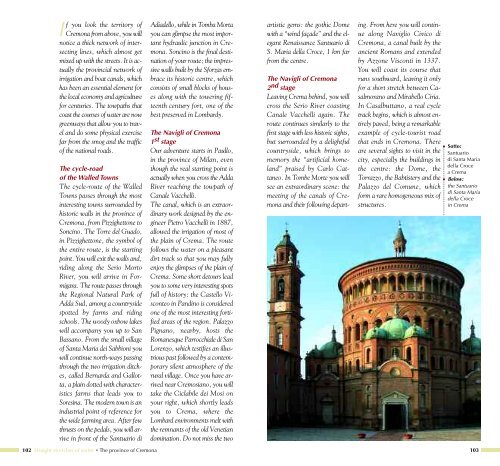mastro Orso
mastro Orso
mastro Orso
You also want an ePaper? Increase the reach of your titles
YUMPU automatically turns print PDFs into web optimized ePapers that Google loves.
If you look the territory of<br />
Cremona from above, you will<br />
notice a thick network of intersecting<br />
lines, which almost get<br />
mixed up with the streets. It is actually<br />
the provincial network of<br />
irrigation and boat canals, which<br />
has been an essential element for<br />
the local economy and agriculture<br />
for centuries. The towpaths that<br />
coast the courses of water are now<br />
greenways that allow you to travel<br />
and do some physical exercise<br />
far from the smog and the traffic<br />
of the national roads.<br />
The cycle-road<br />
of the Walled Towns<br />
The cycle-route of the Walled<br />
Towns passes through the most<br />
interesting towns surrounded by<br />
historic walls in the province of<br />
Cremona, from Pizzighettone to<br />
Soncino. The Torre del Guado,<br />
in Pizzighettone, the symbol of<br />
the entire route, is the starting<br />
point. You will exit the walls and,<br />
riding along the Serio Morto<br />
River, you will arrive in Formigara.<br />
The route passes through<br />
the Regional Natural Park of<br />
Adda Sud, among a countryside<br />
spotted by farms and riding<br />
schools. The woody oxbow lakes<br />
will accompany you up to San<br />
Bassano. From the small village<br />
of Santa Maria dei Sabbioni you<br />
will continue north-ways passing<br />
through the two irrigation ditches,<br />
called Bernarda and Gallotta,<br />
a plain dotted with characteristics<br />
farms that leads you to<br />
Soresina. The modern town is an<br />
industrial point of reference for<br />
the wide farming area. After few<br />
thrusts on the pedals, you will arrive<br />
in front of the Santuario di<br />
102 Straight stretches of water • The province of Cremona<br />
Adiadello, while in Tomba Morta<br />
you can glimpse the most important<br />
hydraulic junction in Cremona.<br />
Soncino is the final destination<br />
of your route; the impressive<br />
walls built by the Sforzas embrace<br />
its historic centre, which<br />
consists of small blocks of houses<br />
along with the towering fifteenth<br />
century fort, one of the<br />
best preserved in Lombardy.<br />
The Navigli of Cremona<br />
1 st stage<br />
Our adventure starts in Paullo,<br />
in the province of Milan, even<br />
though the real starting point is<br />
actually when you cross the Adda<br />
River reaching the towpath of<br />
Canale Vacchelli.<br />
The canal, which is an extraordinary<br />
work designed by the engineer<br />
Pietro Vacchelli in 1887,<br />
allowed the irrigation of most of<br />
the plain of Crema. The route<br />
follows the water on a pleasant<br />
dirt track so that you may fully<br />
enjoy the glimpses of the plain of<br />
Crema. Some short detours lead<br />
you to some very interesting spots<br />
full of history: the Castello Visconteo<br />
in Pandino is considered<br />
one of the most interesting fortified<br />
areas of the region. Palazzo<br />
Pignano, nearby, hosts the<br />
Romanesque Parrocchiale di San<br />
Lorenzo, which testifies an illustrious<br />
past followed by a contemporary<br />
silent atmosphere of the<br />
rural village. Once you have arrived<br />
near Cremosiano, you will<br />
take the Ciclabile dei Mosi on<br />
your right, which shortly leads<br />
you to Crema, where the<br />
Lombard environments melt with<br />
the remnants of the old Venetian<br />
domination. Do not miss the two<br />
artistic gems: the gothic Dome<br />
with a “wind façade” and the elegant<br />
Renaissance Santuario di<br />
S. Maria della Croce, 1 km far<br />
from the centre.<br />
The Navigli of Cremona<br />
2 nd stage<br />
Leaving Crema behind, you will<br />
cross the Serio River coasting<br />
Canale Vacchelli again. The<br />
route continues similarly to the<br />
first stage with less historic sights,<br />
but surrounded by a delightful<br />
countryside, which brings to<br />
memory the “artificial homeland”<br />
praised by Carlo Cattaneo.<br />
In Tombe Morte you will<br />
see an extraordinary scene: the<br />
meeting of the canals of Cremona<br />
and their following departing.<br />
From here you will continue<br />
along Naviglio Civico di<br />
Cremona, a canal built by the<br />
ancient Romans and extended<br />
by Azzone Visconti in 1337.<br />
You will coast its course that<br />
runs southward, leaving it only<br />
for a short stretch between Casalmorano<br />
and Mirabello Ciria.<br />
In Casalbuttano, a real cycle<br />
track begins, which is almost entirely<br />
paved, being a remarkable<br />
example of cycle-tourist road<br />
that ends in Cremona. There<br />
are several sights to visit in the<br />
city, especially the buildings in<br />
the centre: the Dome, the<br />
Torrazzo, the Babtistery and the<br />
Palazzo del Comune, which<br />
form a rare homogeneous mix of<br />
structures.<br />
• Sotto:<br />
Santuario<br />
di Santa Maria<br />
della Croce<br />
a Crema<br />
• Below:<br />
the Santuario<br />
di Santa Maria<br />
della Croce<br />
in Crema<br />
103
















